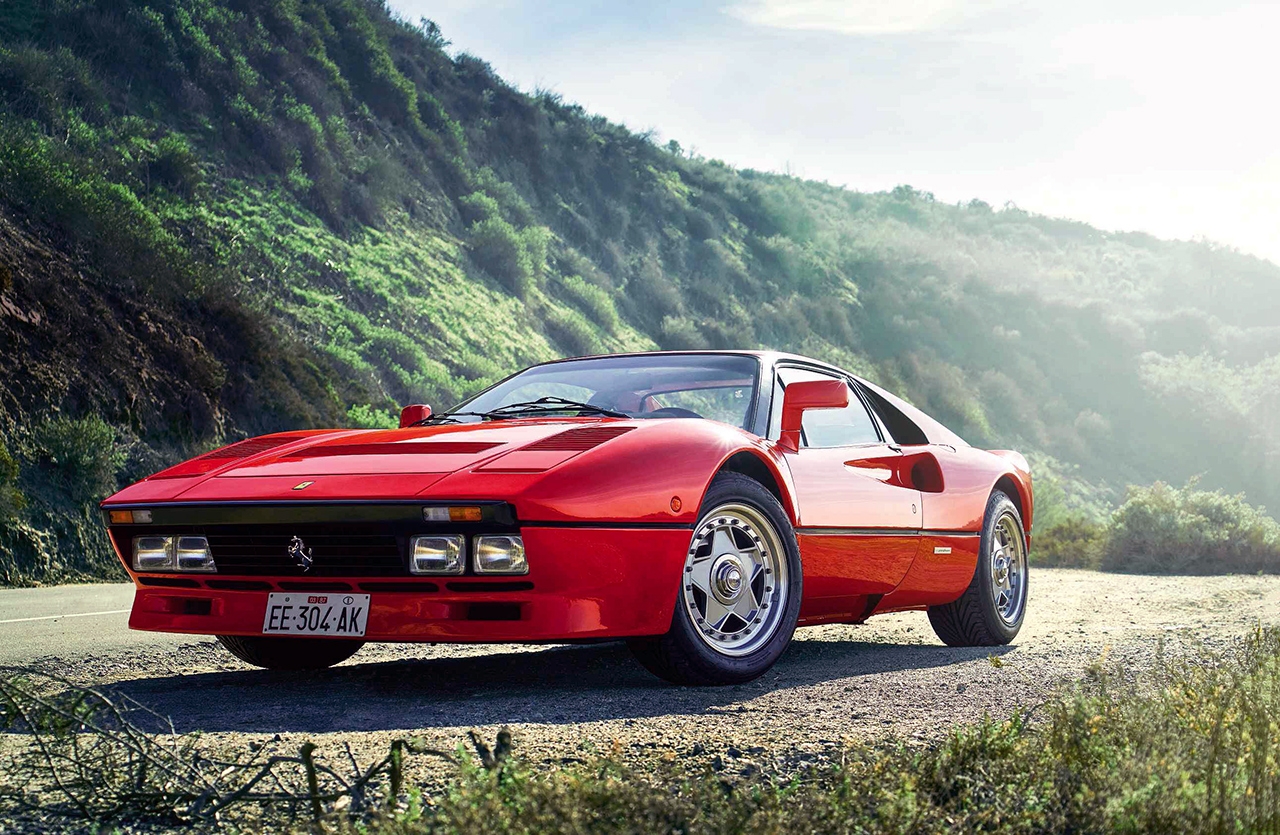
‘Can you feel the tail trying to swing out?’ Niki Lauda on the Ferrari given to him in 1986 Lauda’s Ferrari 288 GTO. Driving the F1 legend’s gift from Enzo PLUS 288 GTO test driver Dario Benuzzi and Formula 1 racers’ daily drivers. Lauda’s 288 GTO The Ultimate Gift Horse. In 1986, multiple Formula 1. World Champion Niki Lauda was given this specially built Ferrari 288 GTO. Now Drive-my drives it. Words Joe Sackey. Photography Webb Bland.
Andreas Nikolaus Lauda is the first name on the ownership document for Ferrari 288 GTO 58329. That’s right: the Austrian F1 driver who was World Champion in 1975, 1977 and 1984 – still the only driver to have been champion for both Ferrari and McLaren.
Lauda’s relationship with Ferrari began in 1974 when his BRM teammate Clay Regazzoni left to rejoin Ferrari, and put in a good word on Lauda’s behalf. Ferrari wasted little time signing him, and Lauda joined the Maranello-based Scuderia at one of its lowest ebbs – yet he succeeded in bringing Ferrari back into the limelight with a World Championship win in 1975. Enzo’s number one pilot, it seemed, could do no wrong.

But it wasn’t always the case. You can read more about Lauda’s turbulent and often astonishing race career on next page, as well as his relationship with Enzo Ferrari – which reached another peak in 1986. That year, he was again taken on by the Scuderia, only this time as a consultant, rather than a driver. And he would need a company car…
Lauda liked the idea of the 288 GTO with its F1-inspired twin-turbo technology. Problem was, production of all 200 cars (to satisfy FIA homologation) had been spoken for already. In fact, more cars had been individually authorised by Enzo Ferrari’s purple ink for royalty and VIPs, the last of which had already been sent to a faithful USA enthusiast and concessionaire. Lauda inquired of the works whether a late order could be satisfied. ‘Impossible!’ came the response.
Never one to give up, Lauda used his restored relationship with Enzo Ferrari to make his request to Fiat CEO Vittorio Ghidella – and Enzo saw the opportunity to show his appreciation to a driver he greatly respected. Fully six months after production had ceased, in March 1986, Ferrari 288 GTO (chassis no ZFFPA16B000058329) was finished at Maranello and signed off by the boss himself. It was a significant gesture, especially given that this GTO was especially costly, thanks to its individual build post production-line.
Lauda’s friend, the Austrian journalist Herbert Völker, recalled his trip with Lauda to collect the car: ‘Although the Lauda-Ferrari relationship had its ups and downs, Niki got a kiss on both cheeks in Imola four or five years before, from which point on things improved considerably. Then, instead of just a kiss, Ferrari gave him a whole car.’
Völker also recalls Lauda asking if he was free for a day-trip. It would involve taking Lauda’s Learjet from Vienna to Bologna, then driving the new 288 GTO back to Salzburg. After landing at Bologna, they were whisked away in an Agusta helicopter to a guarded airfield in Reggio Emilia.
Says Völker: ‘The presentation of the GTO took place secretly because the cost of the car had been split between Fiat and Ferrari. Although it would have been grander to stage the event in Maranello, with more kisses from the boss, at least this way the exclusivity of the proceedings was guaranteed.’
The Italians like to be discreet when they can. Völker recalls that first drive from Reggio Emilia to Salzburg with Lauda behind the wheel as both epic and fast. ‘As a writer one feels professionally obligated to try and find some kind of striking image to describe the impression created by the raw power and thundering musicality of the GTO’s 395bhp twin-turbo engine. The sound is something like the effect of sitting in the middle of a herd of stampeding buffalo, with Indians charging at you from all sides, and 16 coyotes howling in the background.’
And it wasn’t without physical drama, either. ‘Niki had to keep both hands firmly clamped on the wheel. “See how the handling is working?” he had to shout above the engine sound to make himself heard. “Working” in this case meant that the steering wheel was giving Niki a complete shorthand account of the of the road surface. “Can you feel the tail trying to swing out?” asked the champ. Yes I could, and I wish I couldn’t.’

And as for the occasion of driving with a Formula 1 legend: ‘You find you have friends at every toll-booth on the Autostrada, and filling up with gas turns into a party every time you stop. There isn’t an Italian born who doesn’t start twitching when Niki hovers into view.’
After making it back to Salzburg for a late lunch, it was on to Niki’s home: ‘Niki has a garage built into his house, almost like an artist’s studio. You can see into it when you come down the stairs from the living area. Every time you go down the stairs there is a Ferrari waiting to greet you.’
And not just any Ferrari, but a 288 GTO, one specially commissioned by Enzo himself. This writer cannot recall Enzo Ferrari ever bestowing another of his drivers with such a gift in this manner and, in that regard, this GTO underscores how Ferrari felt about Lauda.
Since then, no 58329 has led a charmed life. After spending a number of years in the Lauda garage (it featured in Autocar magazine and the Lewandowski book on the model), it made its way to Ferrari’s own museum, from where its current owner, a US-based collector, bought it. It remains as Lauda collected it from Ferrari, down to the same Escursionisti Esteri 304.AK plates that Lauda used on that drive from Reggio Emilia to Salzburg.
The GTO has benefited from a full mechanical refurbishment at Ferrari Classiche in Maranello, so it is as fit as can be. Perhaps not surprisingly, given that it was purpose-built months after production had ended, this GTO seems to have been built to a standard of fit and finish beyond that of any other. Climbing into the leathertrimmed Kevlar-framed seats, I’m filled with anticipation. It looks, feels, and smells special. Press the starter button and the engine barks.
The air-conditioning blows cold, ground clearance is sufficient that you’re not scraping over every bump, and visibility is fantastic by supercar standards: this car invites you to get in and have a good time. Driving at low speeds in town is easy, the car feels small around you, and the ride is firm, jiggling nervously, but smoothes out as you gather pace. The clutch effort is relatively light for a car with 395bhp, and, after it has properly warmed up, the gearbox operates easily and precisely.
As the going gets faster and twistier, you realise that Ferrari positioned the engine far forward in the chassis to achieve exceptional balance. The car feels rigid, and its non-assisted steering provides amazing feedback. There’s precision and neutrality, but lack of weight is the 288 GTO’s real magic.
Get the car out in the hills and the driving experience is transformed from sports car to supercar. The power is controllable, as the turbos spool-up powerfully but predictably, and they make the car feel even more lightweight and nimble, in a way that makes it difficult to compare to a modern sports car that might be almost twice as heavy. Yet, in contrast to steering that would put any modern electric-racked equivalent to shame, while the brakes are strong and progressive they are nothing like as powerful as those of a modern supercar – and that’s the one area that gives this away as a classic, almost vintage car.
But even that can’t detract from the joy that driving a GTO on a sun-kissed winding road gives the driver. And not just any GTO, this is Lauda’s GTO! A GTO the Old Man himself commissioned for a Formula 1 driver who won the World Championship for him. Twice.
It’s easy to get carried away between a flickering boost gauge, crisp downshifts, blips, and overrun crackles. The photographer, following in the chase car, notes a glorious display of flame-throwing exhaust. It’s going to be hard to top this one for iconic car experiences.
Drive over, I climb out and take a long look back. From behind, you enjoy the car’s width, the curves of the fenders punctuated by the sharp Kamm tail and the sight of the open gearbox. Unforgettable! All the Ferrari supercars that have been developed in the last 30 years have not taken anything away from the allure of the GTO. In many ways, they pay homage to it. Three decades ago, Ferrari hit this one out of the ballpark.
288 GTO: THE MAKING OF AN ICON
A few years ago Ingegnere Nicola Materazzi told me: ‘Il Commendatore had realised, to his considerable disappointment, that customer disenchantment was due to the undeniable fact that the performance of his cars had become more ordinary or mainstream – a term Ferrari himself had used to describe the production models of the early ’80s. This prompted Ferrari to ask for my personal intervention in turning around a situation that had taken a disturbing turn. As a result, I engaged myself in developing models that carry my unequivocal style and signature, starting with the GTO itself.’
The creation of the 288 GTO was a deliberate attempt by Ferrari to hark back to the glory days of its ancestor, the iconic 250 GTO, and generate more interest with a special super-sports line of cars as Materazzi says. It was also built as a homologation series (originally it was intended that no more than 200 would be produced) to qualify for the FIA’s Group B racing series – only for the series to be cancelled.
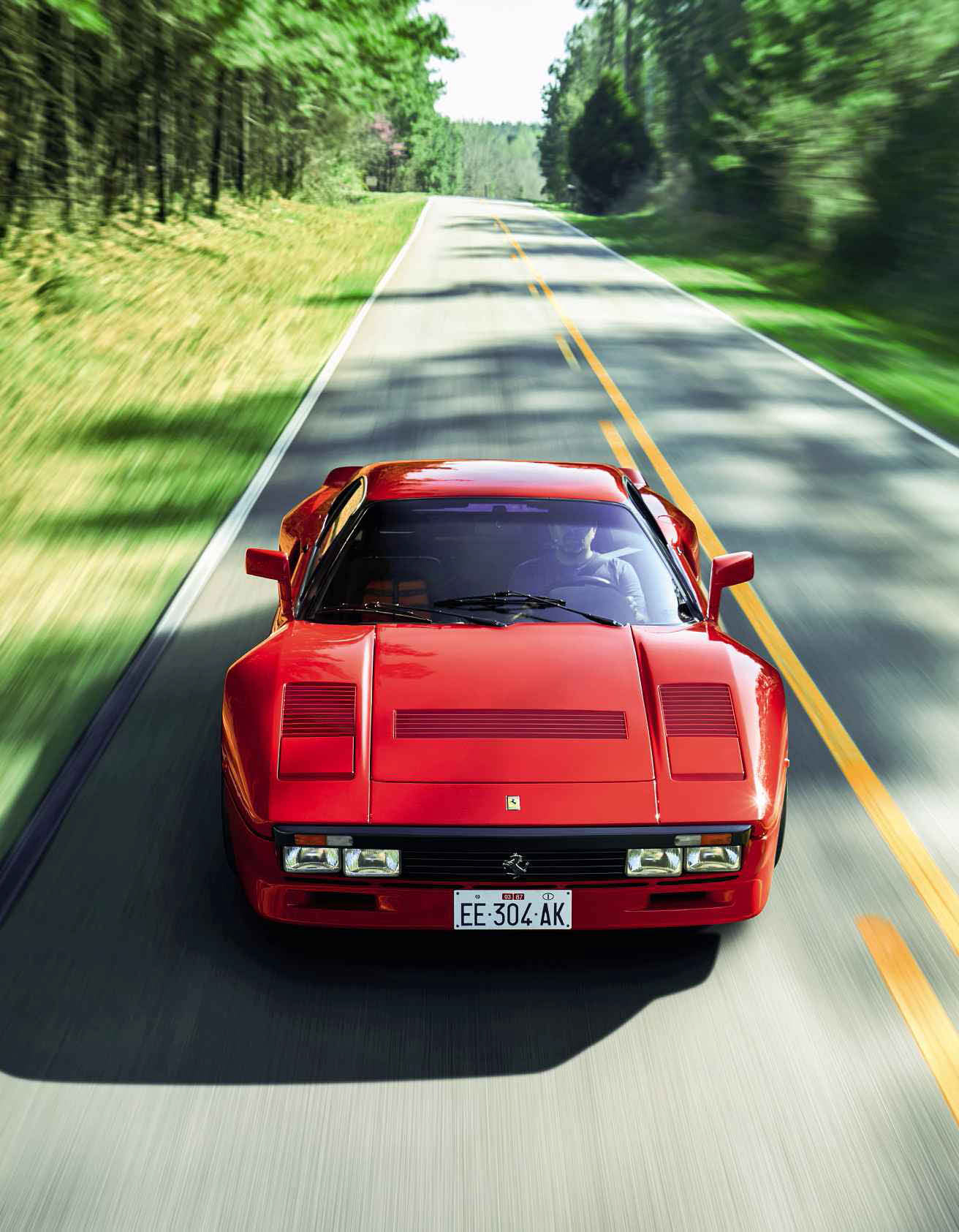
Still, demand was so great on its launch in 1984 that Ferrari eventually built 272 of them. It didn’t need to prove itself in competition. Its performance, rarity and beauty, not to mention those three letters on its rear, meant its instanticon status was set.
This car epitomised a new beginning for Ferrari, serving to popularise its roadgoing cars in a way that previous models had not. It was the last car Enzo Ferrari had any direct influence on: he personally named it and set a mandate for his men. ‘What we have to do is build a new version of the Berlinetta. We shall call it the GTO.’ The GTO is the original ancestor in the line that leads to today’s LaFerrari.
Former F1 world champion Phil Hill, who had a 250 GTO on hand for comparison, found the Ferrari 288 GTO’s cornering prowess ‘phenomenal, noticeably increasing with speed’.
‘In total,’ Hill concluded, ‘the new GTO is miles ahead of its 22-year-old predecessor in performance, yet offers the option of air conditioning and Leoncavallo’s Pagliacci in stereo. As pleased as I am to see Ferrari competing strongly in Formula 1, I am delighted they will once again have gran turismo with true competition potential.’
The 288 GTO remains significant as the first of Ferrari’s roadgoing supercars that employed racing technology adapted for road use. It was fitted with a longitudinally mounted 2855cc V8 equipped with twin IHI turbos (its name denotes 2.8 litres, eight cylinders). Its bodywork was styled by Pininfarina design chief Leonardo Fioravanti, and built from Kevlar and glassfibre honeycomb composite materials for the ultimate combination of strength and lightness, as used on Ferrari’s F1 cars and introduced to the GTO by the company’s F1 designer Dr Harvey Postlethwaite.
Producing 395bhp at 7000rpm through a fivespeed gearbox and a limited-slip differential, the GTO could hit 60mph from a standstill in just 4.8sec and would go on to 189mph (in ‘Evoluzione’ race-spec it could produce 650bhp and, depending on gearing, a top speed of 225mph). Even so, Ferrari pragmatism decreed that type approval of the all-new 288 GTO could be expedited by simply applying for a modification of the original 1975 308 production homologation.
It’s often thought that the engine for the all-new 288 GTO was a turbocharged version of the Type 105/6 series unit from the 308. In fact, the twin-turbo V8 was an engine developed from scratch with Group C Le Mans-winning intent.
Accordingly, the 288 GTO’s engine is a direct descendent of the one that Ferrari developed for the 1983 Lancia LC2 racing coupés, using its own 126C Formula 1 engine for reference.
The new power source had no relationship with the existing 308 unit. It even had to be mounted differently, requiring longitudinal location, with the gearbox fitted to the rear. In fact, it was set so far forward within the chassis that half the engine lay ahead of the bulkhead and nestled between driver and passenger!
Although the new engine sported a plethora of state-of-the-art performance components, the structure of the car came from the tried and tested steel-tube 308. Vented disc brakes, double wishbones and adjustable damping would take care of the forces meted out to it. Inside were Kevlar seats and the dashboard was covered with non-reflective fabric.
During development, Fioravanti worked two or three days a month at Maranello, helping to package the car. Cooling the twin-turbo engine was high on the agenda. Says Fioravanti: ‘The air inlet in the lower part of the body below the door provided fresh air for the brakes and engine compartment. I vented the rear side windows as I’d done on the 512BB Le Mans car: they’re curved in plan view, creating a gap through which air is vented into the engine compartment.’
New rear wings were required, due to the lengthened wheelbase and wider track. However, the car’s strongest visual link with the 1962 GTO came from Fioravanti. ‘It was my choice to add the three cooling outlets aft of the rear wheels.
They’re set at the same angle as those on the original [250 GTO], although the engine positioning was different.’
At the Geneva Salon on 1 March 1984, Enzo Ferrari’s new GTO was unveiled – one on Ferrari’s stand, another on Pininfarina’s – and the rest, as they say, is history.
‘SUBSEQUENT SUPERCARS PAY HOMAGE TO THE GTO. THREE DECADES AGO, FERRARI HIT THIS ONE OUT OF THE BALLPARK’
‘THERE’S PRECISION AND NEUTRALITY, BUT LACK OF WEIGHT IS THE 288 GTO’S REAL MAGIC’
TECHNICAL DATA 1986 Ferrari 288 GTO
Engine 2855cc flat-plane V8, dry sump, DOHC per bank, 32 valves, twin IHI turbochargers, two Behr intercoolers, Weber-Marelli electronic fuel injection
Power 395bhp @ 7000rpm
Torque 366lb ft @ 3800rpm
Transmission Five-speed manual, rear-wheel drive
Steering Rack and pinion
Suspension Front and rear: double wishbones, coil springs, telescopic dampers
Brakes Vented discs
Weight 1160kg
Performance Top speed 190mph / 0-62mph 4.8sec
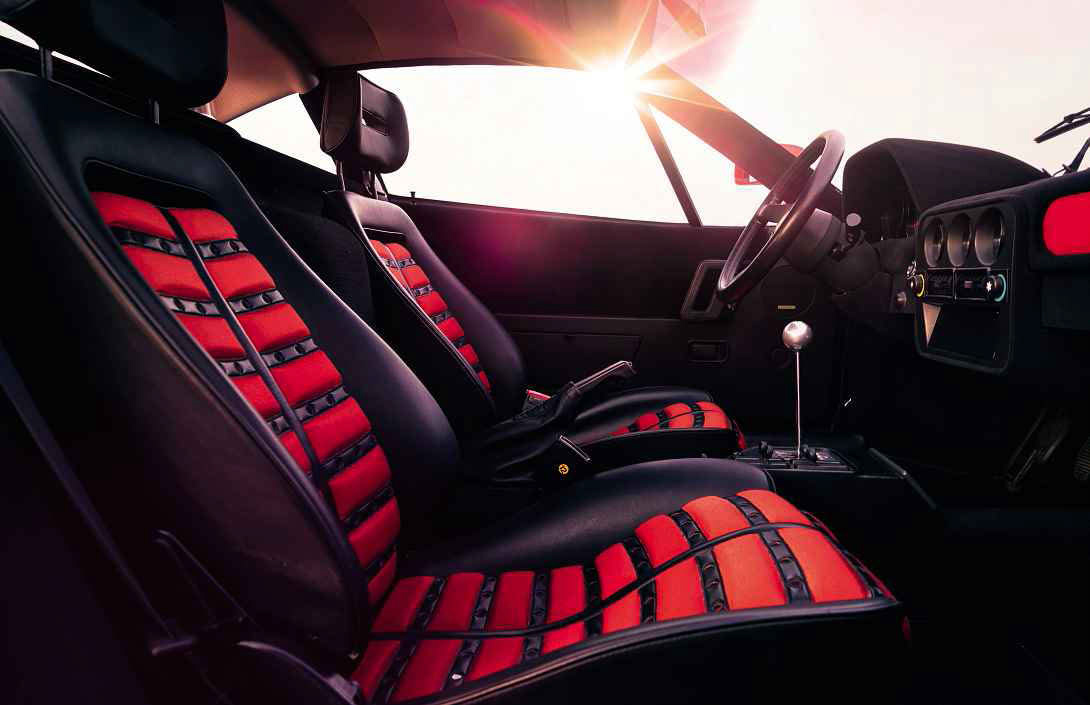
Above and left. Classic Ferrari interior but note how bulkhead bulges into cabin between seats to allow room for the longitudinal engine; on the road it’s a world apart from the similar-looking 308.
‘GET THE CAR OUT IN THE HILLS AND THE DRIVING EXPERIENCE IS TRANSFORMED FROM SPORTS CAR TO SUPERCAR’
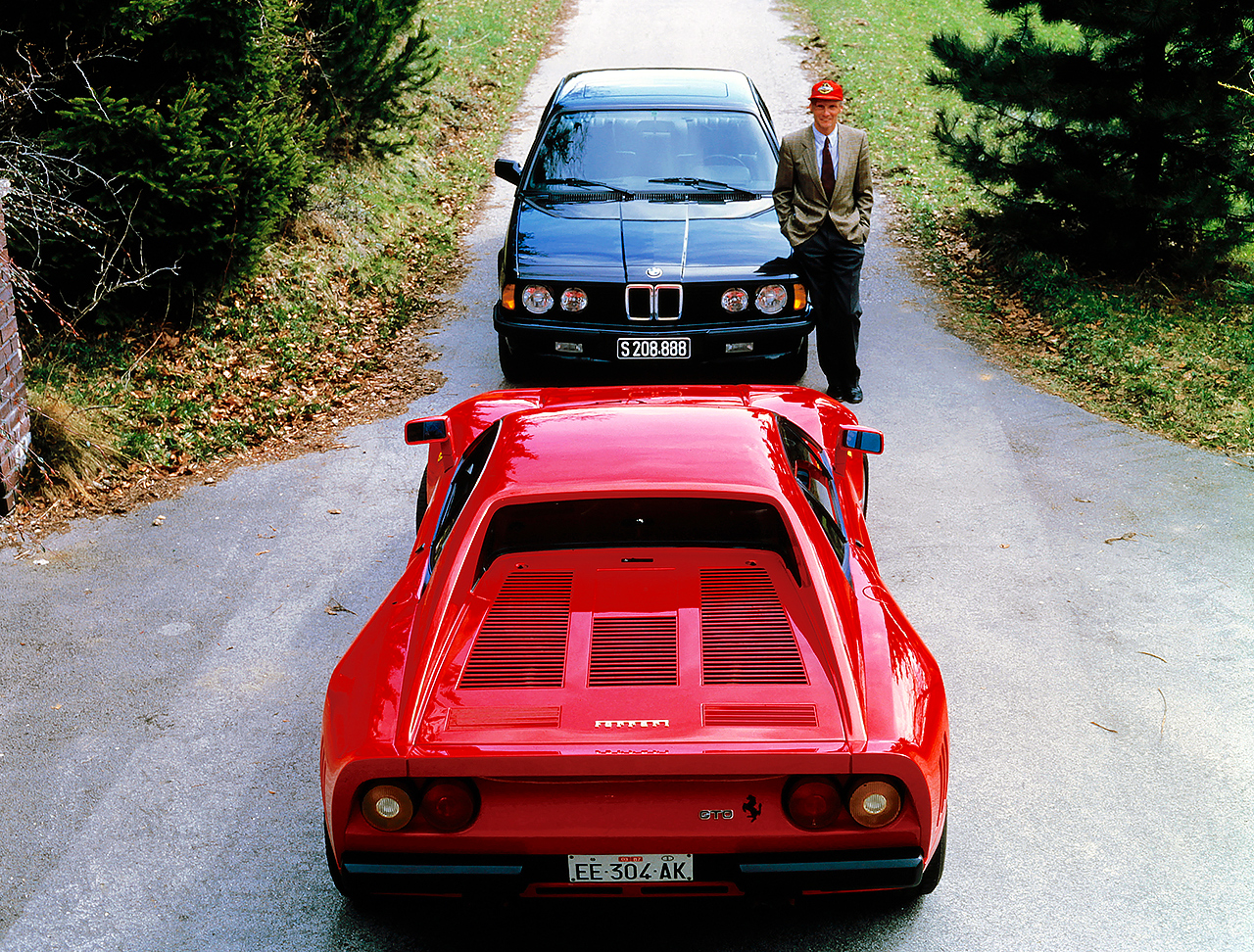
Top, above and right Enzo Ferrari and Niki Lauda captured together; Lauda with his 288 GTO – and his BMW 7-series; that same 288 GTO today.
NIKI LAUDA, FERRARI – AND THAT CRASH
At the height of his career, Lauda suffered one of F1’s worst ever accidents. But it didn’t stop him racing. Words Joe Sackey.
At the 1976 German Grand Prix at the Nürburgring, even though he was the fastest driver on that circuit at the time, Lauda begged his fellow drivers to boycott the race because of the circuit’s poor safety provisions. Most of his colleagues voted against the boycott and the race went ahead. Then came one of the worst F1 accidents of the era.
On the second lap at the fast left kink before Bergwerk, Lauda’s Ferrari swerved off the track, hit an embankment, and burst into flames. His Ferrari made contact with another car and Lauda was trapped in the wreckage. Arturo Merzario, Brett Lunger, Guy Edwards and Harald Ertl braved the flames to rescue Lauda from his car. By the time he could be freed, he had suffered severe burns to his head and inhaled hot toxic gases.

Although Lauda was conscious immediately after the accident, he lapsed into a coma. He suffered extensive scarring from the burns to his head.
With Lauda seemingly out of the Championship for the rest of the year, Enzo Ferrari lost no time in signing Carlos Reutemann as his replacement.
However, in an unparalleled feat of courage, Lauda returned only six weeks (just three races!) later, appearing at the Monza press conference with his fresh burns still bandaged. He finished fourth in the Italian GP, despite not being fully recovered, wearing a specially adapted AGV crash helmet. Renowned F1 journalist Nigel Roebuck recalls seeing Lauda in the pits, peeling the bloodsoaked bandages off his scarred scalp.
In Lauda’s absence, Hunt had mounted a late charge to reduce Lauda’s lead in the World Championship standings. Following wins in the Canadian and United States GPs, Hunt stood only three points behind Lauda before the final race of the season, the 1976 Japanese GP at Fuji.
Lauda qualified third, just behind Hunt, but on race day there was a torrential downpour and Lauda decided to retire after two laps. He felt it was unsafe to continue under these conditions.
Hunt finished third – and won the title by a single point! Even though Lauda’s decision to retire at Fuji was universally respected, Enzo Ferrari was furious. He believed that Lauda should have persevered and finished, underscored by the fact that the weather cleared up later in the race. Instead, he’d given the Championship away. Enzo didn’t like to lose face. Ever.
Lauda’s do-no-wrong relationship with Enzo Ferrari ended abruptly and he endured a difficult 1977 season, despite easily winning the World Drivers’ Championship again. Lauda disliked his new teammate, Reutemann, and the fact that Ferrari had hired him so quickly in 1976 did not help matters. As Lauda said later: ‘We never could stand each other, and instead of taking pressure off me, they put on even more by bringing Carlos Reutemann into the team.’
Although Lauda announced his decision to quit Ferrari at season’s end, he left with two races still to run after Enzo Ferrari decided to run the unknown Gilles Villeneuve in a third car at the Canadian Grand Prix. Reutemann became the number one driver, putting the final nail in the coffin of the Lauda-Ferrari relationship.
Lauda joined Brabham in 1978, for a then unheard-of $1-million salary, but his next two seasons were marred by retirements, and at the 1979 Canadian Grand Prix Lauda announced he was leaving the sport. Since resigning from Ferrari he had founded his airline, Lauda Air, and he returned to Austria to run it full-time.
Yet in 1982 Lauda came back to racing, this time with McLaren, winning a third World Championship in 1984 by half a point over teammate Alain Prost, five years after his first retirement, beating Ferrari in the process. Il Commendatore was impressed, to say the least.
The year after, Lauda scored only a single win, at the Dutch Grand Prix, where he held off a fast finishing Prost late in the race. It was his final F1 victory, and Lauda announced his retirement at the 1985 Austrian Grand Prix.
Again, he returned to running his airline, but Enzo Ferrari lost no time proposing to Luca de Montezemolo that he should hire Lauda as a consultant at Ferrari as part of an effort to rejuvenate its ailing Formula 1 team. Italian politics being what they are, a visit to Maranello was arranged, and Lauda’s official employer became Fiat, in a PR capacity. Naturally, this position came with its perks, not least of which was the choice of anything Maranello produced. And the rest we now know.
‘F1 JOURNALIST NIGEL ROEBUCK SAW LAUDA IN THE PITS, PEELING THE BLOOD-SOAKED BANDAGES OFF HIS SCARRED SCALP’
INSIDE MAN
Dario Benuzzi became Ferrari’s chief test driver in the 1970s. Here he tells Massimo Delbò about his experiences developing the 288 GTO.
Dario Benuzzi joined Ferrari as a mechanic in 1971, when he was 25 years old. He was soon assigned to the prototype department and then became the go-to test driver of every car to wear the Cavallino Rampante. His work spread from prototypes to production cars and on to Formula 1; the most important racing drivers of the last 40 years appreciated his craft.
In the 1980s he was testing what would become the first real Ferrari supercar since the Boxer: the 288 GTO. ‘I knew the 308 very well because I’d been deeply involved in the pre-production development. Then, in 1982-1983, rumours came from the technical department of a new eight-cylinder, twin-turbo, super-sports car.’
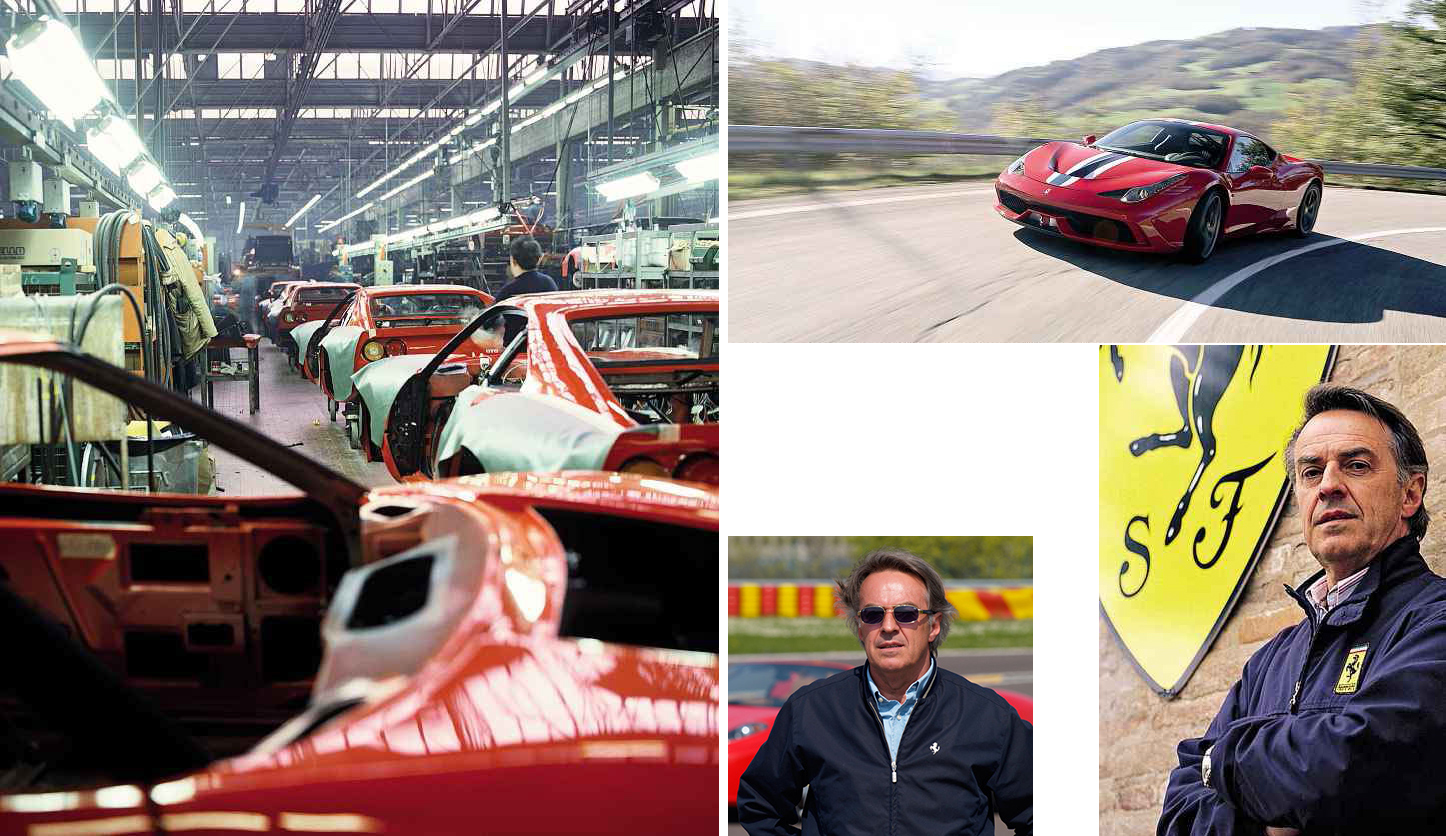
Clockwise from opposite page Dario Benuzzi has been a test driver at Ferrari for more than four decades; 288 GTO production at Maranello; Benuzzi was responsible for cars such as the Boxer, then the 288 GTO – and, more recently, the 458 Speciale, which he’s seen here driving.
The new car would bring important technical innovations for the company, including dual turbochargers and the use of ultra-lightweight materials, such as the honeycomb front end and the mix of honeycomb and Kevlar for the firewall.
‘You never expect to make a brand-new model complete from day one,’ says Benuzzi; ‘you begin with components coming separately to be independently tested. When more parts receive a basic approval, you try the driving position in a wooden mock-up, and eventually there is the very first prototype to drive. The first ride is very important because the car is already talking to you and the test driver immediately understands whether, before all the development, there is a good base to start with. With the 288 GTO I was immediately in love because the car felt right within the first few metres. It felt special; it was easy to perceive the benefits of the lower centre of gravity, the fantastic power-to-weight ratio and the fact it weighed 100kg less than the 308.’
To today’s eyes the power seems less impressive: that magic number of 400PS (actually 395bhp) is now the territory of a good sports saloon. ‘Forget the maximum output, because it is not the secret of the 288. The real secret weapon of this car, still incredible by today’s standards, is the power-to-weight ratio: new cars offer more than 600bhp, but they weigh so much more than the 1160kg dry weight of the GTO, so they are far from its 2.2kg for every horsepower.’
Among the positive attributes were obviously aspects that required further development. Benuzzi is silent for a few seconds, then he lowers his voice as if to protect his creation from being criticised. ‘We knew from the beginning that we would have it sorted out, but it took a very long time to develop the dual integrated Weber-Marelli indirect injection-ignition systems. It was totally new, the wastegate system always active so that, as soon as you released the gas pedal, it created gunfire and flames. With today’s programming this could be solved in a few days but, back then, it took months of long days involving me and a Weber technician. After each test, the technician would record my feelings, together with the data.
Then overnight, he would modify the printed circuit so I could test it the following day. It was a difficult process, but I was pleased with the results, because you can drive the GTO in any conditions without suffering because of the engine.’
In the 1980s, drivers were used to turbo lag, and also the kick received when the turbo started working. With the GTO you feel an immense power, pushing you in a never-ending surge.
‘It would have been easy to keep the kick of the turbo to give the feeling of huge power. But – and this is my personal signature on the GTO, and I’m very proud of it – my idea was for a car that was very progressive, its power emerging without interruption. I wasn’t testing a Porsche 930 that needs to give the feeling of power, I was testing the most powerful production Ferrari ever, and my duty was to make it fast and beautiful to drive, in every condition, from the city to a racetrack, even on a wet road.’
Benuzzi continues: ‘I had to achieve it without electronic handling aids and also had to maintain the right exhaust sound.’ He wasn’t entirely alone in this quest, however. ‘We were a team of four: Cimatti in the development department, Maurizio Manfredini for the engine, plus me and Stefano Govoni in testing. Today, with computer support, Ferrari would assign 40 people.’
Even now, Dario Benuzzi has probably driven the 288 GTO further than anyone else. His testing involved long road journeys from Maranello to Nardò, the test track at Puglia, in the far south of Italy. ‘Today we are all spoilt, taking aeroplanes so often,’ he says. ‘Back then we drove, because every kilometre meant a little more experience. I can’t remember how many times I drove the GTO to and from Nardò, where we did the acceleration and brake tests, but I vividly remember when we did it in one day. Maranello to Nardò is a distance of 900km and I was in the car with Govoni. We arrived at the track at about 12 o’clock and did the tests for the day, 500-600km done very fast, and we were supposed to stay at the Hotel President in Lecce because the homologation test team was there. We went out for dinner and realised that there were no rooms available so we decided to drive back home. We said we would stop if we were tired, but by 2am we were back home, after 2500km of driving in one day!’
Many who drive the 288 GTO for the first time are impressed by how easy it is to manoeuvre at low speed, and how friendly it feels even with larger throttle inputs.
‘A production car is always made of compromise,’ says Benuzzi. ‘The test driver is always thinking “What if…” You have to know when to stop. The 300km/h target was interesting, and was a speed that the early 512 BB could already achieve. So our target was to go as fast in a less stressful way. In the GTO, when you are driving on the long highway corners between Bologna and Firenze, and you are passing other cars, you feel that relaxing light understeer, and the tail following without moving. This is the way a supercar should drive, without causing the driver’s hands to sweat. But when you go on the racetrack, you can drive it with the gas pedal, it is easy to control in countersteer. I still remember my first drive as a licensed Ferrari test driver with the Daytona, and the effort in driving it in countersteer, and I’m very proud of the difference I helped to create.’
Of course, hindsight is wonderful, and so is the prospect of going back to improve something. Benuzzi: ‘The 288 GTO is an almost perfect car. I say almost because, in the days before electronics, the F40 was the perfect car. What I’d add to the GTO is power steering, partly because it makes everything easier, but mostly because using it would allow more direct steering. What remains a big question mark is the tyres. We could have chosen from four suppliers but, for commercial reasons, we went with Goodyear. I would have liked to see the work of other manufacturers too.’
When the car was launched and journalists were invited to test it – ‘On the passenger side,’ adds Benuzzi, ‘because Enzo Ferrari always said “If they want to drive my car they have to buy it”’ – the 288 GTO went on the cover of magazines everywhere in the world. From day one it was the must-have supercar – and Enzo himself had the final word on the styling. ‘Ferrari came to visit the Reparto Costruzione Prototipi and saw the first model being built. He asked for stronger, more muscular rear fenders and a differently shaped rear air extractor. It is that part of the design that became an iconic symbol of the car.’
‘WE SAID WE WOULD STOP IF WE WERE TIRED, BUT BY 2AM WE WERE BACK HOME, AFTER 2500KM OF DRIVING IN ONE DAY!’





